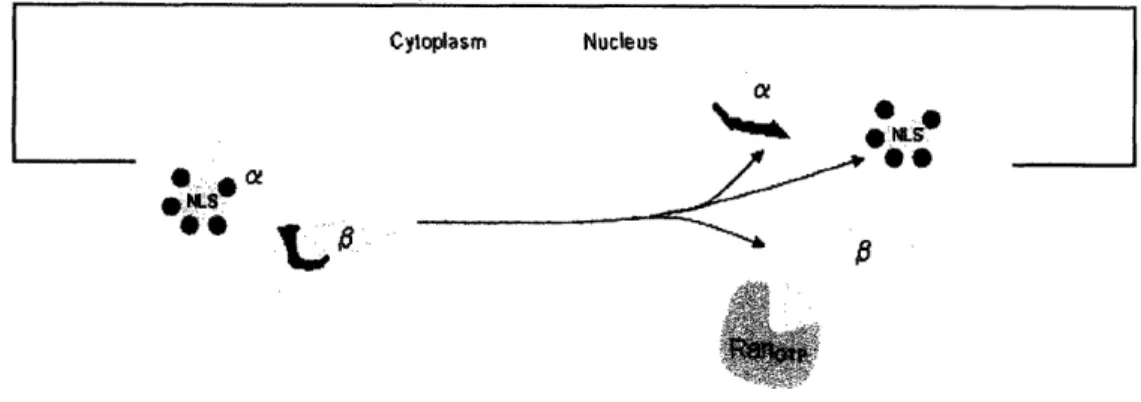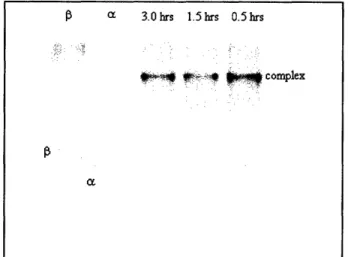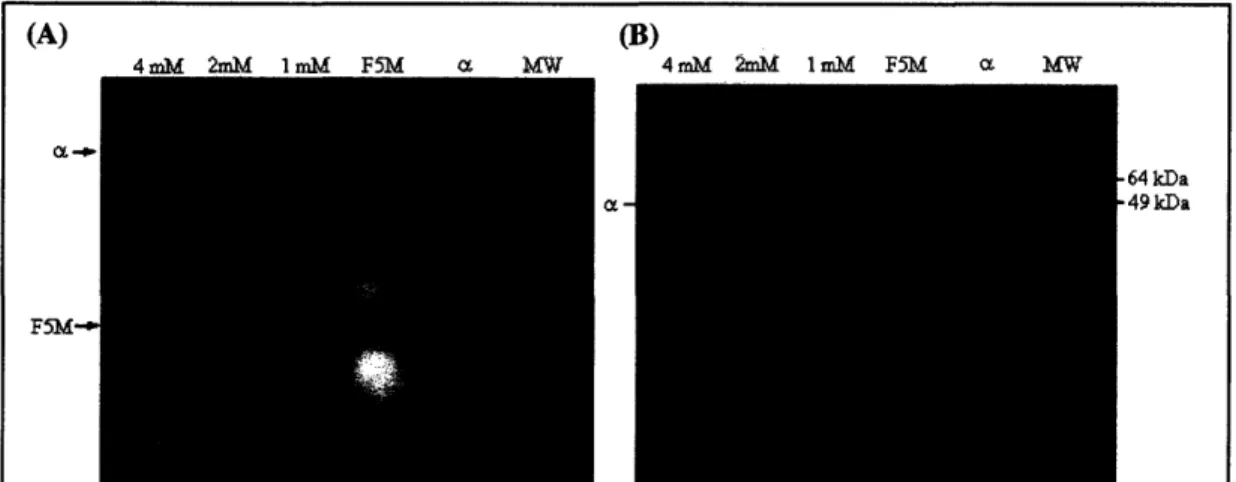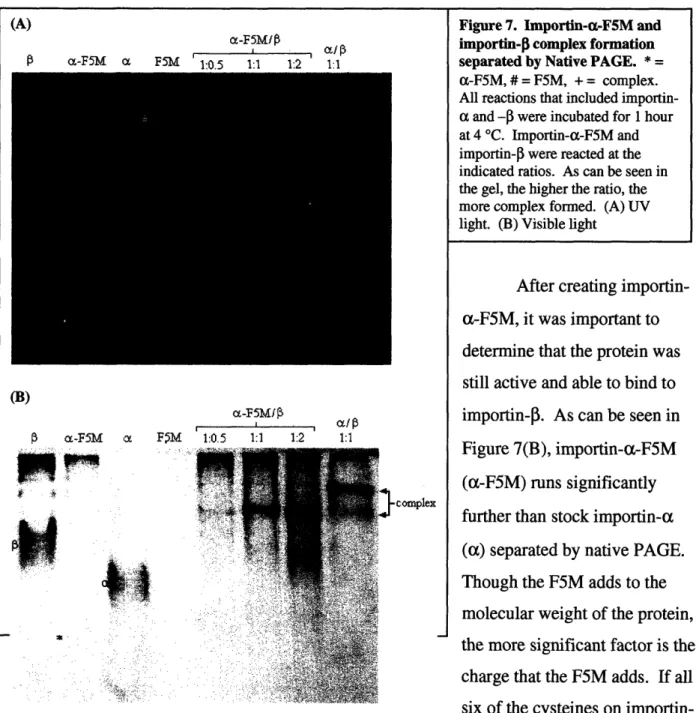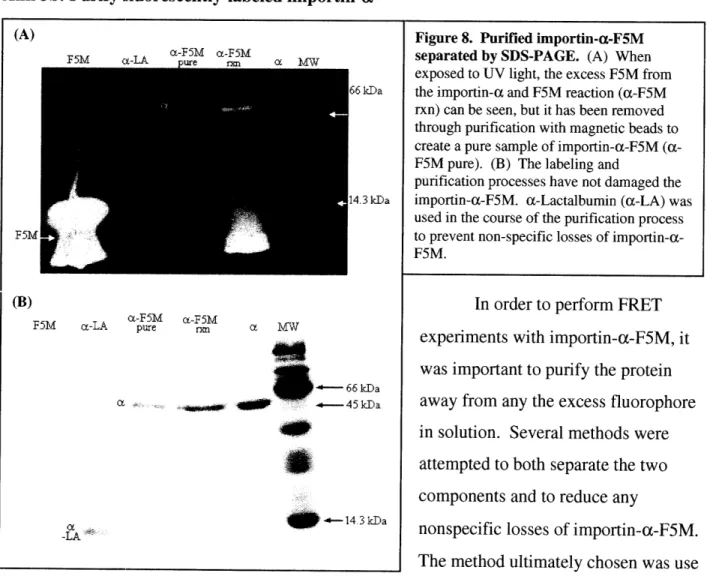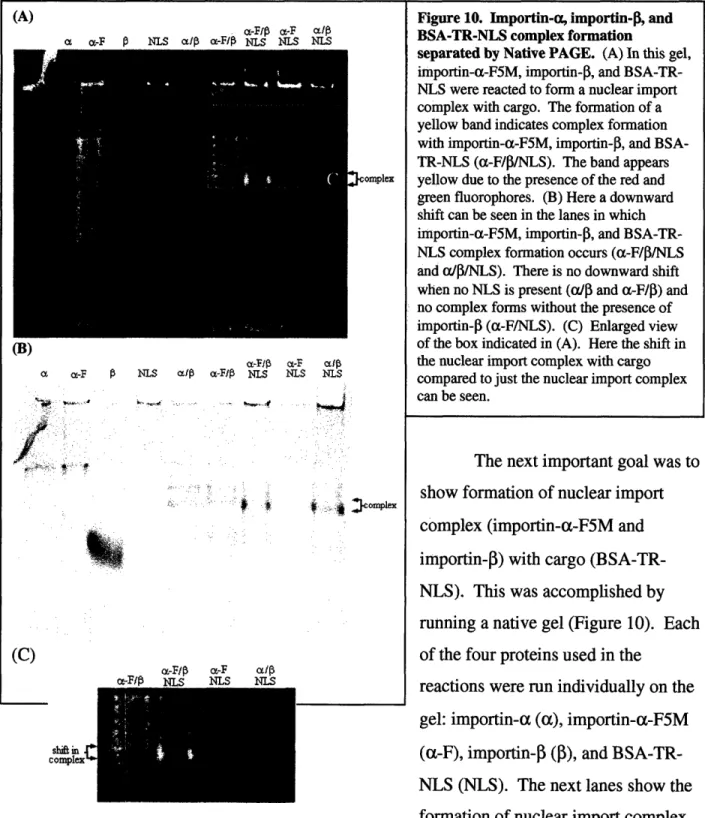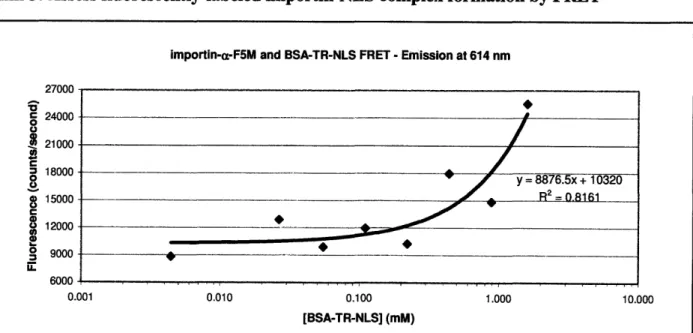Design of an in vitro assay to optimize assembly of nanoparticle-tagged nuclear import complexes
by
Lara Elise Rosenbaum
SUBMITTED TO THE DEPARTMENT OF MECHANICAL ENGINEERING IN PARTIAL FULFILLMENT OF THE REQUIREMENTS FOR THE DEGREE OF
BACHELOR OF SCIENCE
AT THE
MASSACHUSETTS INSTITUTE OF TECHNOLOGY
JUNE 2007
©2007 Lara Elise Rosenbaum. All rights reserved. The author hereby grants to MIT permission to reproduce
and to distribiite publicly paper and electronic copies of this thesis document in whole or in part
in any medium now known or hereafter created.
Signature of Author: - -
---Lara Elise Rosenbaum Department of Mechanical Engineering May 11, 2007
Certified by: I - IVI
Kimberly Hamad-Schifferli Assist atr of Mechanical Engineering and Biological Engineering
Accepted by: MASSACHUSETTS INSTITUTE MASSACHUSETTS INSTITUTE OF TECHNOLOGY
JUN 2 1 2007
LIBRARIES~IT-~ Professor of Mechanical EngineeringJohn H. Lienhard V
airman, Undergraduate Thesis Committee
ARCH1VSI
FC=1 M,1 -~r~c··
... JE .... #
Design of an in vitro assay to optimize assembly of nanoparticle-tagged nuclear import complexes
by
Lara Elise Rosenbaum
Submitted to the Department of Mechanical Engineering on May 11, 2007 in partial fulfillment of the
requirements for the Degree of Bachelor of Science in Engineering as recommended by the Department of Mechanical Engineering
Abstract
Maintaining protein function at the biological-inorganic interface is a critical challenge for bionanotechnology. Specifically, nanoparticle-protein conjugates must be designed to interact
with binding partners with biologically-relevant thermodynamics. Towards developing a nanoparticle-tagging system that minimizes interference with normal protein function, here we
design and begin development of an assay to assess complex formation between nanoparticle-immobilized proteins and soluble binding partners.
Two chaperone proteins, importin-a and importin-3 mediate classical nuclear transport, an essential and highly conserved example of protein complex formation in eukaryotic cells. Together, these two proteins form a chaperone complex that recognizes a nuclear localization signal (NLS), which is a short peptide sequence.
Here, we synthesize and purify a fluorescently-labeled importin-a and a positive control for complex formation, which consists of bovine albumin serum (BSA) covalently conjugated to a fluorophore and NLS. Using these two fluorescent molecules, we can perform Forster
Resonance Energy Transfer (FRET) experiments to study the kinetics and thermodynamics of these protein interactions. The development of this system will be used in future tests with the NLS-conjugated fluorescent gold nanoparticles.
Thesis Supervisor: Kimberly Hamad-Schifferli
Introduction
Nanoparticles have many unique properties that allow them to be used as fluorescent, magnetic, electron-density, or spectrophotometric tags on biomolecules. Using nanoparticles as tags offers biologists many new technological possibilities that are only starting to be developed.
One method of particular interest is to use these nanoparticles to monitor protein complex formation. In this project, we have designed and developed a nanoparticle-tagging system to minimize interference with normal protein function. To do so, we have first designed an in vitro assay to study the proteins of interest under normal physiological conditions, as documented in the literature. In future studies, nanoparticles will be used to tag some of these proteins, and this novel approach can be used to provide highly quantitative data.
1. Nuclear Import
One method employed by cells to transport proteins from the cytoplasm into the nucleus is through the use of members of the importin family, an essential and highly conserved example of protein complex formation in eukaryotic cells. This task can be broken down into two main steps: nuclear import complex formation followed by the nuclear import process. The two nuclear transport proteins, called importin-a and importin-P, form a chaperone complex which recognizes a nuclear localization signal (NLS), which is a short peptide sequence within a
protein. When the importin-alimportin-0 complex binds to an NLS on a cargo protein, the entire chaperone-cargo complex is imported from the cytoplasm into the nucleus of the cell. This process is important for normal cellular function2; therefore, it is a valuable test-bed on which to develop our technology.
A. Nuclear Import Complex Formation
Both importin-a and importin-3 are necessary for the nuclear import complex formation. Importin-a contains two NLS binding sites and an importin-p-binding (IBB) domain. An NLS binding site recognizes and attaches to an NLS in a protein. The IBB domain is an
autoinhibitory domain which binds to the NLS binding sites in the absence of importin-3. Once importin-P binds to the IBB domain of importin-a, importin-a has a high affinity for and binds
to an NLS sequence' (Figure 1). As there is only one IBB domain in importin-ca, importin-a and importin-0 form a complex in a 1:1 molar ratio.
B. Nuclear Import Process
Once the entire nuclear import complex has formed, it can be transported from the cytoplasm into the nucleus of the cell. Importin-0 is responsible for docking importin-a and its cargo (the protein containing the NLS) to the nuclear pore complex (NPC). Importin-P,
importin-a, and the NLS-containing protein are then brought through the NPC and into the nucleus of the cell. There, by interacting with another protein, importin-P is removed from importin-a, releasing the IBB domain, and importin-a releases its cargo and converts to the
low-affinity form by binding to the freed IBB domain. Importin-a and importin-0 are then exported from the nucleus to be used again in the cytoplasm.2'3 (Figure 2)
Figure 2. Diagram of Nuclear importation (Figure modified from (5) Lelyveld 2006). NLS = NLS-containing protein, a = importin-a, 13 = importin-1, RanGTp: This
protein causes importin-13 to release the IBB domain, leading to the dissociation of the entire importin-a, importin-13, and NLS-containing protein complex.2
(A) (B) (C)
NLS binding sites
IBB domain
Figure 1. Nuclear import protein complex formation (Figure modified from (5) Lelyveld 2006). a = importin-a, 3 = importin-j3, NLS = NLS-containing protein. (A) Importin-a, contains two NLS binding sites that are blocked by the IBB domain. (B) Importin-03 binds to the IBB domain of importin-a, exposing the two NLS binding sites. (C) An NLS conjugated to a
2. Forster Resonance Energy Transfer (FRET)
Forster Resonance Energy Transfer (FRET) is a well-established technique for monitoring interactions between biomolecules. For the in vitro assay, a short NLS has been covalently attached to fluorescently-labeled bovine serum albumin (BSA), and importin-a has been labeled with fluorescein, a chemical fluorophore. By using Forster Resonance Energy Transfer (FRET) between the two fluorescent tags, the kinetics and thermodynamics of the protein interactions can be quantitatively measured and analyzed. The system has been designed such that the conditions are as close to physiological-relevance as possible. Each part of the assay has been optimized, including the stoichiometry of complex components and the reaction conditions for importin-a fluorescent labeling and BSA fluorescent labeling and NLS
conjugation. Additionally, the proper design of the interface between the two proteins is critical. The dynamic protein structure is an important parameter to consider to prevent labeling the proteins in such a way that interferes with binding.
FRET takes advantage of overlapping excitation and emission spectra of different fluorescent molecules or fluorophores. One fluorophore, the donor, can be excited, and the excited electrons within the fluorophore transfer their energy to a nearby different fluorophore, the acceptor. This different fluorophore then emits its own unique spectrum (Figure 3). There is no photon release by the donor fluorophore. The proximity of the two fluorophores is extremely important and occurs most efficiently at distances of 2 - 10 nm.7 This range works well for the
vast majority of protein-protein interactions which take place over similar distances.
Donation Excitation f Emission · f" i *1 ,YI~/ V,/ Z~t-400 440 480 520 580 800 640 680 Wavelength (nm) Figure 3. Example excitation and emission spectra (Figure from (5) Lelyveld 2006). The
overlap of the emission spectra (solid green) of fluorescein with the excitation spectra (dashed blue) of Texas Red is required for FRET. The excitation (dashed green) and emission (solid green) spectra of fluorescein and the excitation (dashed blue) and emission (solid blue) spectra of Texas Red are shown.
3. Gold nanoparticles
This assay is ultimately being developed for use with fluorescent gold nanoparticles. Novel quantum physical properties that are not apparent in bulk materials are observable in nanoscale materials. It has been shown that small gold clusters exhibit size-tunable fluorescence and quantum yield. We believe that because of their high quantum yield, blue-fluorescing Au8 is
ideal for use in FRET experiments. They have less than a 1.2 nm hydrodynamic radius and are stabilized with polyamido-amine (PAMAM) dendrimer.6' 12 This dendrimer consists of many branches ending with primary amines. The primary amines on the PAMAM dendrimer allow it to be easily reacted with short NLS peptides (Figure 4).
Specific Aims
There are five major steps in designing this in vitro assay.
Aim 1: Optimize reaction conditions for importin-a and importin-j3 complex formation Aim 2: Design and synthesize a fluorescently-labeled importin-a
Aim 3: Purify and functionally characterize fluorescently-labeled importin-a
Aim 4: Design, synthesize, and test an NLS-displaying fluorescent protein conjugate to
assess fluorescently-labeled importin complex function
Aim 5: Assess fluorescently-labeled importin-NLS complex formation by FRET
(A) (B) .Y . : 500 ¶ .II.. L '· 0 - • - " ... 10I 41) 500 bOO W7ý0 Wavelength nm
Figure 4. Aug-PAMAM. (A) (Figure from (5) Lelyveld 2006) The primary amines on the PAMAM dendrimer allow it to react with a short NLS peptide and the Aug in the center confers the fluorescence necessary for FRET experiments. (B) (Figure from (6) Zheng 2003) 1. The excitation (purple) and emission (blue) spectra of Aus-PAMAM. 2. A vial of Au8-PAMAM excited at 366nm.
Methods
Materials: His6-tagged Importin-a2, His6-tagged importin-3pl, and 4-Maleimidobutyric acid
ester (GMBS) were obtained from Sigma-Aldrich. Importin-a was stored in 20 mM HEPES, pH 7.3, 100 mM potassium acetate, 2 mM DTT, 5% glycerol, and 0.02% TRITON X-100.
Importin-P3 was stored in 20 mM HEPES, pH 7.5, 110 mM potassium acetate, 2 mM magnesium acetate, 0.5 mM EGTA, 0.1 mM ATP, 2 mM DTT, 5% glycerol, and protease inhibitors. Bovine serum albumin (BSA) was obtained from New England Biolabs (NEB).
Fluorescein-5C-maleimide (F5M) and Texas Red Fluorescein-5C-maleimide (TR) are from AnaSpec. The NLS was synthesized by Genscript with the following protein sequence: N'-CTTTYGGPKKKRKVG-C'.
Native PAGE and SDS-PAGE gels: All gels consisted of an 8% (w/v) polyacrylamide resolving
gel and a 4% (w/v) polyacrylamide stacking gel, except for the gel shown in Figure 10, which contained a 7% (w/v) polyacrylamide resolving gel. The gels were stained with Safestain
Protein Stain (Invitrogen) following the recommended protocol.
Importin-a-F5M conjugation and purification: Importin-a was reacted at 6.6 pM with 1 mM
F5M (final concentrations) for 1 hour at 4VC unless otherwise noted (Appendix C). Magnetic His-Select Ni-NTA beads (Sigma-Aldrich) beads were prepared as recommended, and were blocked with 1 ml of 1 pg/ml a-lactalbumin (a-LA, Sigma-Aldrich) for 15 min at 40C. The
a-LA was removed from the beads and then the beads were incubated with the importin-a-F5M sample for 45 min at 40C. The recommended protocol was followed to clean the beads and then
elute the sample from the beads. A minimum of 4 washes was required to remove the free F5M from the sample. The elution buffer used was 50 mM sodium phosphate, 0.3 M sodium chloride and 250 mM imidazole.
BSA-TR-NLS conjugation: The BSA was first incubated with TR maleimide at a 10 fold molar
excess at 40C for 30 min. Next, the BSA was incubated with GMBS at a 20 fold molar excess at 40C for 60 min. The excess GMBS and fluorophore were then removed by running the sample
over a 30 kDa MWCO Microcon centrifugal filter (Millipore). Finally, the purified BSA-TR-GMBS conjugate was incubated with NLS at a 20 fold molar excess at 4'C for 60 min and purified using a 30 kDa MWCO Microcon filter (Appendix C).
FRET experiments: Importin-a-F5M (263 nM) and importin-0 (3125 nM) were held constant in
the reactions (final concentrations). BSA-TR-NLS was added to the reactions at concentrations of 1597 nM, 883 nM, 441 nM, 221 nM, 110 nM, 55 nM, 26 nM and 4 nM (final concentrations). These reactions were allowed to incubate at 4oC for 60 min. Control reactions were also made that included the same concentrations of BSA-TR-NLS but no importin-a-F5M or importin-f. Fluorescence spectra were measured in a Jobin Yvon Fluoromax-3 Fluorometer.
Results
Aim 1: Optimize reaction conditions for importin-a and importin-03 complex formation
We first sought to establish that recombinant His6-tagged importin-a2 and importin-131
interact to form a protein complex. A 1:1 molar ratio of importin-a and importin-P was
incubated for 0.5 hours, 1.5 hours, or 3.0 hours and were separated by native polyacrylamide gel electrophoresis (PAGE) and Coomassie stained. As can be seen in Figure 5, the maximum amount of complex formed within 0.5 hours and an increase in incubation time did not allow for increased apparent complex formation. Also note that complex formation occurred despite the presence of detergent (Triton-X 100) in the importin-a storage buffer.
P 3.0hrs 1.5 hrs 0.5 hrs
S-~i complex
Figure 5. Importin-a and -I complex formation. Importin-a and importin-3 were incubated at a 1:1
molar ratio for 3.0 hrs, 1.5 hrs, and 0.5 hrs, separated by native PAGE, and Coomassie stained. The gel indicates that 0.5 hrs is sufficient for maximum complex formation.
Aim 2: Design and synthesize a fluorescently-labeled importin-a
The cysteines on importin-a were the targets for this reaction for three reasons. 1) The chemistry of reacting cysteines with a maleimide-fluorophore is well characterized and easily accomplished under safe and normal laboratory conditions (Appendix C). 2) There are only six cysteines in importin-a, with only two of them being internal and the remaining four external (Appendix A). 3) None of the cysteines are within 5
A
of the NLS binding sites nor are there cysteines in the IBB domain. Lysine was also considered as a target, but since there are 28 lysines in importin-a, it was determined that the cysteines were far better targets for the reasons listed above. Since there is dithiothretol (DTT) in the stock importin-a obtained from the manufacturer, it was necessary to react importin-a with a substantial excess of fluorophore to ensure labeling. (DTT reacts with the fluorophore through the same chemistry as a cysteine on importin-a.) The fluorophore chosen was fluorescein-maleimide (F5M). Fluorescein has an excitation spectrum that overlaps well with the emission spectrum of Aus, thus making it a good candidate for FRET with Aus, and fluorescein also has a good emission spectrum to overlap with Texas Red, another fluorophore, which is also used in this project.The stock solution of importin-a contains 2mM DTT, thus we chose to react the
importin-a with 4 mM, 2 mM, and 1 mM F5M (final concentrations). As can be seen in Figure
(A) (B) 4mM 2mM I1mM F5M MW 01-4 F5M-l 64 kDa 49 kfa
Figure 6. Importin-a-F5M reaction separated by SDS-PAGE. (A) This gel shows that
labeling importin-a with fluorescein-maleimide (F5M) overnight at 4 TC results in fluorescent importin-a. Three F5M concentrations were used: 1mM, 2mM and 4mM. The minimum concentration used (1 mM F5M) was sufficient to label the protein. (B) There is no discernable size difference between importin-a-F5M and importin-a.
6, all three F5M reactions created fluorescent importin-a (Fig. 6A) and showed no shift in position on an SDS gel when compared to stock importin-a (Fig. 6B).
Aim 3a: Functionally characterize fluorescently-labeled importin-a (A) Fc-F5MI/ I ) - c/
P
a-F5Ma~
F5M lr% 1.1 1 -1) 1.1 "" ".-a:'.:?o::• , .. • ;. ,..'/ .. . .: complexFigure 7. Importin-a-F5M and importin-[ complex formation separated by Native PAGE. * =
a-FS5M, # = F5M, + = complex.
All reactions that included importin-a importin-and -0 were incubated for 1 hour
at 4 TC. Importin-a-F5M and importin-0 were reacted at the indicated ratios. As can be seen in the gel, the higher the ratio, the more complex formed. (A) UV light. (B) Visible light
the more significant factor is the charge that the F5M adds. If all
six of me cysteines on
importin-a reimportin-act with F5M, this importin-adds importin-approximimportin-ately six negimportin-ative chimportin-arges to the protein, resulting in
greater mobility in the gel. This property can also be seen in the lanes in which complex was formed (a-F5M/I and aW1). The a-F5MIP complex runs at a faster rate than the a/3 complex. Additionally, there is an increase in complex formation as the ratio of a-F5M :
P
increases. In(B)
a--F5M/P
I alp
B a-a5vf a F5M 1:0.5 1:1 1:2 1:1
After creating importin-a-F5M, it was important to determine that the protein was still active and able to bind to importin-3. As can be seen in Figure 7(B), importin-(-F5M (a-F5M) runs significantly further than stock importin-a
(a) separated by native PAGE.
Though the F5M adds to the molecular weight of the protein, x;
Figure 7(A), we can see that all complex bands fluoresce under ultraviolet (UV) light and therefore contain a-F5M.
Aim 3b: Purify fluorescently-labeled importin-a (A) <F~M j kDa 3kDa F5M a As4 466kDa -- 144 3 kDa -LA
Figure 8. Purified importin-a-F5M separated by SDS-PAGE. (A) When exposed to UV light, the excess F5M from the importin-a and F5M reaction (a-F5M rxn) can be seen, but it has been removed through purification with magnetic beads to create a pure sample of importin-a-F5M
(a-F5M pure). (B) The labeling and
purification processes have not damaged the importin-a-F5M. a-Lactalbumin (c-LA) was used in the course of the purification process to prevent non-specific losses of importin-a-F5M.
In order to perform FRET experiments with importin-a-F5M, it was important to purify the protein away from any the excess fluorophore in solution. Several methods were attempted to both separate the two components and to reduce any
nonspecific losses of importin-a-F5M. The method ultimately chosen was use magnetic nickel affinity beads that would bind to the poly-histidine tag on importin-a-F5M. As can be seen in Figure 8(A), there is considerable excess fluorophore before purification (a-F5M rxn) but no excess fluorophore after the purification process (a-F5M pure). Additionally, the importin-a-F5M was not degraded or damaged during the purification process (Fig 8(B)). (a-Lactalbumin (a-LA) was used in the course of the purification process to prevent nonspecific losses of importin-a-F5M. Since a-LA is not histidine tagged, little remains in the purified sample of importin-a-F5M and since a-LA has not been fluorescently labeled nor does it bind to importin-P or NLS, it does not interfere with the FRET experiments.
(B)
F5 -F5M -L c-F5M
S
d66-kDa
Aim 4a: Design and synthesize an NLS-displaying fluorescent protein conjugate to assess fluorescently-labeled importin complex function
(A) (B)
BSA-TR-NLS BSA-TR-NLS
MT R.qA nrod rnm 1 rn 2 Ma R•SA prod.rtm 1 nm 2
M(1)
66-lcDa
Zsbift
The next important step in the development of this assay was to show that the
importin-Oc-F5M/importin-fi complex is able to bind to NLS to complete the formation of a nuclear import complex with cargo. To accomplish this goal a protein needed to be created that contained an
NLS. With this end in mind, bovine serum albumin (BSA) was reacted with Texas Red
maleimide (TR) (to block the single cysteine in BSA and create a fluorescent molecule), then reacted with a heterobifunctional crosslinker to link a small portion of the lysines on BSA to a short peptide containing the NLS sequence PKKKRKV (Appendix C). As can be seen in Figure 9(A), a fluorescent BSA was created (BSA-TR-NLS prod.), indicating that the Texas Red properly reacted with the BSA. In Figure 9(B and C), the final product (BSA-TR-NLS prod) is larger than unreacted BSA, indicating that it is likely that BSA-TR-NLS was created (the addition of the NLS peptides provide a noticeable increase in the molecular weight of the protein.)
Figure 9. BSA-TR-NLS reaction separated by SDS-PAGE. (A) When exposed to UV light, the bovine serum albumin-Texas Red-NLS conjugate (BSA-TR-NLS) fluoresces red. The final BSA-TR-NLS product (prod.) can be seen in the center of the gel. Samples were taken during intermediate steps of the creation of BSA-TR-NLS (rxn 1 and rxn 2) to monitor the creation of the final product. (B) When compared to unreacted
BSA, the BSA-TR-NLS product is slightly larger. This observation, combined with the fluorescent image,
suggests the successful creation of BSA-TR-NLS. (C) Enlarged view of the box indicated in (B). Here the shift in the BSA-TR-NLS compared to the BSA can be seen.
e' 'I~i~j~i~~
Aim 4b: Test an NLS-displaying fluorescent protein conjugate to assess fluorescently-labeled importin complex function
(A) a-F/I a-F Cl=P a -F P NLS aClp C-F/P NLS NLS NLS }complex (B) a c -F NLS al a-FI- NLS NLS NLS
/...-.•!
4 omple(C)
a--FIB aC-F a/B
(a/3 and a-F/P), one with the fluorescently labeled importin-a (a-F/P) and one without (a/3).
In the gel observed under UV light (Fig. 10(A and B)), the fluorescently-labeled nuclear import complex (a-F/P) fluoresces green due to the presence of the F5M. In the next lane, the nuclear
Figure 10. Importin-a, importin-0, and BSA-TR-NLS complex formation
separated by Native PAGE. (A) In this gel,
importin-a-F5M, importin-P, and
BSA-TR-NLS were reacted to form a nuclear import
complex with cargo. The formation of a yellow band indicates complex formation with importin-a-F5M, importin-0, and BSA-TR-NLS (a-F/JI/NLS). The band appears yellow due to the presence of the red and green fluorophores. (B) Here a downward shift can be seen in the lanes in which importin-a-F5M, importin-|3, and
BSA-TR-NLS complex formation occurs (a-F/P/BSA-TR-NLS
and aI3/NLS). There is no downward shift when no NLS is present (aP4 and a-F/I) and no complex forms without the presence of importin-|3 (a-F/NLS). (C) Enlarged view of the box indicated in (A). Here the shift in the nuclear import complex with cargo compared to just the nuclear import complex can be seen.
The next important goal was to show formation of nuclear import complex (importin-a-F5M and importin-0) with cargo
(BSA-TR-NLS). This was accomplished by
running a native gel (Figure 10). Each of the four proteins used in the
reactions were run individually on the gel: importin-a (a), importin-a-F5M (a-F), importin-P (3), and
BSA-TR-NLS (BSA-TR-NLS). The next lanes show the
import complex with cargo can be seen (a-F/p/NLS) and it appears yellow due to the
combination of green-fluorescing F5M and red-fluorescing TR. In the next lane (a-F/NLS), the lack of importin-P does not result in any visible complex formation. In the last lane (cP3/NLS) the nuclear import complex with cargo can also be seen, though it now appears red due to the presence of only TR (and no F5M). Under visible light (Fig. 10(B)), it is evident that the nuclear import complex with cargo (a-F/P/NLS and a/p/NLS) travels further in the native gel than the nuclear import complex without cargo (a/P and a-F/P) and that no complex forms when importin-P is absent (a-FINLS).
Aim 5: Assess fluorescently-labeled importin-NLS complex formation by FRET
The final important experiment completed for this project was to perform a FRET experiment between importin-a-F5M and BSA-TR-NLS. Several mixtures of importin-a-F5M and BSA-TR-NLS at known concentrations (Appendix B) and controls of BSA-TR-NLS alone at those same concentrations were made and allowed to equilibrate. Emission and excitation scans were measured of each sample. The data was controlled for background noise and non-specific effects by subtracting the control sample (BSA-TR-NLS only) from the experimental sample (importin-a-F5M and BSA-TR-NLS) with corresponding BSA-TR-NLS concentrations.
importin-a-F5M and BSA-TR-NLS FRET - Emission at 614 nm u0007 c 24000 0 21000 = 18000 15000 C 8 12000 S9000 6000 0.001 0.010 0.100 1.000 10.000 [BSA-TR-NLS] (mM)
Figure 11. FRET between imporin-a-F5M and BSA-TR-NLS. When mixtures of importin-a-F5M and
BSA-TR-NLS are excited at 492 nm (the excitation peak of F5M), some of the energy is transferred to TR which results in the emission of light at 614 nm (the emission peak of TR). This data is plotted as a function of BSA-TR-NLS concentration. Each sample has a fixed concentration of 0.263 mM importin-a-F5M.
Two important effects must be considered in a FRET experiment to show that FRET is occurring within a sample. First, when the sample is excited at the excitation peak of F5M (492 nm) energy should be transferred to TR and emitted at the emission peak of TR (614 nm). No emission will occur at 614 nm unless FRET is occurring. The data from a scan of this sort (exciting at 492 nm and measuring the emission at 614 nm) can be seen in Figure 11. As can be noted, the emission at 614 nm rises well above background, especially at the highest
concentrations of BSA-TR-NLS. Second, if energy is being transferred from F5M to TR (i.e. FRET is occurring), the emission of F5M at its emission peak (515 nm) would be expected to decrease as the concentration of BSA-TR-NLS increases. This is due to the fact that more and more energy is being transferred to the TR instead of being emitted by the F5M as the TR concentration increases. This reduction in emission of F5M is termed 'quenching' and the data can be seen in Figure 12. As in the Figure 11, nonspecific effects of BSA-TR-NLS
concentration are controlled for by subtracting the corresponding BSA-TR-NLS control sample from each experimental data point. The quenching data assumes a shape opposite that of the emission of TR due to the corresponding energy transfer that occurs.
importin-a-F5M and BSA-TR-NLS -Emission at 515 nm
430000 A 410000 8 390000 370000 2o 350000 S330000 2 310000 0 " 290000 y = -54324x + 375275 R2= 0.4801 270000 ... 0.001 0.010 0.100 1.000 10.000 [BSA-TR-NLS] (mM)
Figure 12. Quenching of importin-a-F5M due to FRET. When the mixtures of importin-a-F5M and BSA-TR-NLS are excited at 492 nm (the excitation peak of F5M), energy is transferred from the F5M to the TR. If this occurs, the emission of F5M at its emission peak (515 nm) decreases as a function of increasing amounts of BSA-TR-NLS. Each sample has a fixed concentration of 0.263 mM importin-at-F5M.
Discussion
This project was based on the concept that rational design of a protein modification protocol could produce the covalent conjugates importin-a-F5M and BSA-TR-NLS in a manner that allowed these proteins to interact normally. Accordingly, we focused on comparing the binding interaction of the two conjugates versus the unconjugated proteins. The first step was to determine how the unaltered proteins interacted. This step was accomplished by the native gel shown in Figure 5. There, the complex is clearly visible as a new band that is not present when either importin-a or importin-f is run alone. Incubating importin-a and importin-P together for just 30 minutes allows for complex formation to approach to equilibrium.
The next major step was to label importin-a with F5M, purify it, and show that the
protein continues to function normally. Importin-a-F5M does not significantly gain in molecular weight when labeled with F5M (Fig. 6(B)), but it does clearly fluoresce green under UV light (Fig. 6(A)). Additionally, the purification process does not damage the protein, nor are there significant losses (Fig. 8). The culmination of this step was to determine whether or not importin-a-F5M continued to function in the same manner as unlabelled importin-a. From the gel shown in Figure 7, three important observations are made. First, importin-a-F5M does indeed form a nuclear import complex with importin-3, just like unlabelled importin-a. This can be seen in the a-F5M/P lanes (a-F5M/P) when compared to the
importin-alimportin-0 lane (alP). Second, the greatest amount of nuclear import complex does not occur at the predicted stoichiometric ratio of 1 importin-a : 1 importin-P. Instead, the maximum amount of complex occurs at a ratio of 1:2. This may be due to some inefficiency in binding due to the presence of the F5M. Third, the importin-a-F5M/importin-3 complex travels further through the gel than the unlabelled importin-al/importin-P complex. This extra movement is due to the addition of an increase in negative charge associated with conjugating F5M to a protein. The increase in molecular weight (which should retard movement down the gel) is negligible
when compared to the increase in negative charge. This reasoning is further verified by reconsidering Figures 6 and 8 which shows no discernable increase in importin-a-F5M's molecular weight when compared to importin-a. It is also verified by looking at the lanes in Figure 7 which correspond to importin-a-F5M alone (a-F5M) and importin-oc alone (a). Here,
importin-a-F5M moved significantly further in the gel compared to importin-a, again, due to the increase in negative charge which greatly overcomes the slight increase in molecular weight.
An important control in this project was the development of a positive control for the formation of nuclear import complex with cargo. This control was accomplished by conjugating BSA, TR, and a short NLS to create BSA-TR-NLS. As seen in the gel shown in Figure 9, the protein created is both fluorescent and slightly larger than pure BSA, suggesting that the intended product, BSA-TR-NLS was correctly synthesized. Unfortunately, it should be noted that there are many other bands in the BSA product lane. These higher bands are likely to be dimers, trimers and other polymers of BSA. Additionally, there may be a faint band of a degradation product of BSA. For the purposes of later experiments, the concentration of the BSA-TR-NLS was calculated based on the total concentration of all protein in solution
(including the larger dimers and trimers and the degradation products) (see Appendix B). This concentration was chosen because all of the lanes are fluorescent and thus presumably all of these bands also contain NLS, based on the chosen reaction conditions (which include a 20 times excess of crosslinker and a 20 time excess of NLS). Future studies should work to create a pure BSA-TR-NLS that contains neither smaller nor larger protein products. In this manner, the homogeneity and the activity of the protein would not be brought into question. As this data indicates, there is some question as to if and how readily each of these bands is able to interact with importin-a-F5M and importin-P to form a nuclear import complex with cargo.
The question of the activity of the BSA-TR-NLS was tested by running the native gel shown in Figure 10. The important features of this gel are the lanes in which complex is formed. Here, there is clearly nuclear import complex formed in both the importin-alimportin-f3 (a/3) lane and the F5M/importin-3 (a-F/P) lane. Additionally the
importin-a-F5M/importin-3 lane fluoresces green due to the presence of F5M. In the next lane, which contains importin-a-F5M, importin-P, and BSA-TR-NLS, there is also complex formation, but this complex travels slightly further down the gel and fluoresces yellow. This indicates the
successful formation of a nuclear import complex (green) with cargo (red), which appears yellow when occurring together. Additionally, nuclear import complex with cargo forms in the same location in the importin-alimportin-3/BSA-TR-NLS (a/J/NLS) lane. Note that in the lane lacking importin-3 (a-F/NLS), no complex forms. The nuclear import complex with cargo travels further in the gel than the nuclear import complex alone. Though the nuclear import
complex with cargo is larger in size than just the nuclear import complex, the cargo adds additional negative charges to the complex as a whole and therefore it is pulled further through the gel. This is evident in both lanes which contain importin-a, importin-P and BSA-TR-NLS (a-F/P/NLS and a/I/NLS).
The culmination of this project is the FRET experiment between importin-a-F5M and BSA-TR-NLS. The important FRET data to consider are the data gathered when the sample is excited at the excitation peak of F5M. Two important data sets are generated: the data from the emission peak of TR and the data from the emission peak of F5M, which both give a measure of the transfer of energy from F5M to TR. In the former data set (Figure 11), there is an upward trend as a function of concentration of BSA-TR-NLS. Energy from the excitation of F5M is
available for transfer, so the more BSA-TR-NLS in solution, the more energy gets transferred, and the more fluorescence is measured at 614 nm (the emission peak of TR). In the latter data set (Figure 12), there is a decreasing trend as a function of concentration of BSA-TR-NLS. As more energy is transferred from the F5M, less is emitted by the F5M at its emission peak (515
nm).
The curves generated in both Figure 11 and Figure 12 should be sigmoidal in shape. Unfortunately, the mixtures used in this experiment did not go up to a high enough concentration of BSA-TR-NLS to saturate all of the importin-a-F5M in solution, thus, the beginnings of a sigmoidal shape can be seen in the figures, but not the entire curve. From previous studies of importin-a, importin-3, and NLS interactions, the dissociation constant (Kd) of nuclear import complex and NLS was measured to be 33 nM, using NLS-GFP with importin-a and importin-p.8
This Kd is significantly smaller than the Kd predicted from the data gathered here. There are several likely explanations to explain this discrepancy. First, it may be that not all of the BSA-TR-NLS is able to bind to importin-a-F5M. From Figure 9, it is observed that there are several protein bands in the BSA-TR-NLS and it is possible that not all of these bands correspond to viable protein for the assay. If the data is compensated for this relative decrease in
concentration, the graph shown in Figure 11 shifts left on the scale of BSA-TR-NLS
concentration (moving closer to the accepted Kd value). However, this shift still does not go far enough down on the scale to predict a Kd of even the same magnitude as given in the literature.
(It appears that the Kd from this adjusted data would still be an order of magnitude higher (data not shown).) Another possible explanation for the discrepancy is that not all of the
BSA-TR-NLS is conjugated to BSA-TR-NLS. If this were the case, there would be BSA-TR in solution that is unable to form nuclear import complex (due to the lack of NLS). Therefore, much more BSA-TR-NLS would need to be added than what was thought to get the required concentration of NLS. This would cause the sigmoid data to shift to the right (away from the accepted Kd value) as has happened in the data reported here. Additionally, it is possible that the NLSs on the BSA are not readily accessible to the importin-ac-F5M, and thus, much larger amounts would also be needed than was originally thought. The other possible problem may be with the importin-a-F5M. If there are six F5M on some of the importin-a (but not all) it is possible that the addition
of these F5M are partially blocking the NLS binding sites, though based on the analysis of the importin-a's structure this is unlikely. (None of the cysteines that the F5M react with are within
5 A of the NLS binding sites.) Interference with importin-f3 is unlikely as none of the six cysteines is in the IBB domain of importin-a. Finally, it could be a problem with the
combination of these two engineered proteins, importin-a-F5M and BSA-TR-NLS. It is possible that the NLS, conjugated to the BSA-TR, and the importin-a, conjugated to several F5M, do not interact as easily as importin-a and NLS do naturally. Or, it could be that the FRET does not occur very efficiently between importin-c-F5M and BSA-TR-NLS. If the TR and the F5M are not sufficiently close to each other energy will not be transferred between the two fluorophores. In conclusion, further experiments need to be performed to fully understand this in vitro system and to achieve the goal of fully designing a nanoparticle-tagging system to study protein interactions. The focus of future experiments should be on developing a cleaner sample of BSA-TR-NLS to dispel questions regarding the activity of this control, performing further FRET experiments that fully capture the sigmoid of the data in order to capture an accurate Kd for the system developed here, and finally, creating and using Aus-PAMAM-NLS in FRET experiments with importin-a-F5M. Through the careful development of each of these engineered proteins and the nanoparticle-tagged NLS, highly quantitative data has been and will be collected to
analyze and understand the formation of a nuclear import complex with cargo.
Acknowledgements
We would like to thank Kimberly Hamad-Schifferli for her support and guidance during the course of this project, without which this project would not have been possible. We would like to thank Victor Lelyveld for his invaluable time spent in the laboratory, his thoughtful
explanations and insights, and his patience. We would like to also thank all of the members of the Hamad-Schifferli group for their lively and insightful discussions.
References
1. Kobe B. Autoinhibition by an internal nuclear localization signal revealed by the crystal structure of mammalian importin a. Nature 1999;6(4):388-97.
2. Gorlich D, Kutay U. Transport between the cell nucleus and the cytoplasm. Annu. Rev. Cell Dev. Biol. 1999;15:607-60.
3. Cingolani G, Petosa C, Weis K, Muller CW. Structure of importin-f3 bound to the IBB domain of importin-a. Nature 1999;399:221-9.
4. Kalderon D, Roberts BL, Richardson WD, Smith AE. A short amino acid sequence able to specify nuclear location. Cell 1984;399:499-509.
5. Lelyveld VS. Biomolecular Remote Control over a Synthetic Nuclear Transport Substrate in
Live Cells. [Dissertation proposal] Cambridge (MA): Massachusetts Institute of Technology; 2006.
6. Zheng J, Petty JT, Dickson RM. High quantum yield blue emission from water-soluble Au8
nanodots. J. Am. Chem. Soc. 2003;125:7780-1
7. Szollosi J, Damjanovich S, Matyus L (contributors). Current protocols in cytometry: 1.12.1
-1.12.13. John Wiley & Sons, Inc.: 1999.
8. Fanara P, Hodel MR, Corbett AH, Hodel AE. Quantitative Analysis of Nuclear Localization Signal (NLS)-Importin a Interaction through Fluorescence Depolarization. J. Biol. Chem. 2000;278(28):21218-23.
9. Catimel B, Tehl T, Fontes MR, Jennings IG, Jans DA, Howlett GJ, Nice EC, Kobe B.
Biophysical characterization of interactions involving importin-alpha during nuclear import. J. Biol. Chem. 2001;276:34189-98. (PDB 11Q1)
10. Cell Signaling Technology. "ARM domain." Structure from: Conti, E. et al. Cell. 1998; 94(2):193-204. <http://www.cellsignal.jp/reference/domain/arm.php> (Image of importin-a)
11. Schreiber, F. Physical and Theoretical Chemistry Laboratory: The Schreiber Group.
< http://www.physchem.ox.ac.uk/-fs/index.html?sams.html> (Image of BSA)
12. Zheng J, Zhang C, Dickson RM. Highly fluorescent, water-soluble, size-tunable gold quantum dots. Phys. Rev. Lett. 2004;93(7):077402.
Appendix A
Figure 13. 3-D image of importin-a. Two NLS peptides (orange) are bound to the two NLS binding sites in
importin-a. The six cysteines in importin-a are labeled and indicated in green. Every cysteine is more than 5 Ai from the NLS binding sites.9
Appendix B: Determination of importin-a-F5M and BSA-TR-NLS concentration
The concentrations of importin-a-F5M and BSA-TR-NLS were determined by running the protein sample in an SDS-PAGE gel alongside protein standards of known concentration
(either importin-a or BSA) (Figure 14 A, B). Intensity plots for each lane of the Coomassie stained gel were obtained using ImageJ software. Using a standard curve of band intensity
versus protein samples of known concentration (Figure 14 C, D) and the intensity of the
unknown protein sample (either importin-a-F5M or BSA-TR-NLS), the concentration of the sample was estimated (Figure 14 E).
(A) BSA (LM) NLS 10,05 O. 12 1 2 5000 4000 3000 2000 1000 0 0.2 0.4 0.6 0.8
BSA concentration (IuM)
(B) cM (6M) MW a-FSM 2.6 13 0.66 033 66. kDa"• •••++, .. -BSA (D) 20000 5 15000 10000 5000 0
importin-a standard curve
Band intensity I Concentration (gM)
BSA-TR-NLS Band 1 5546 1.3 Band 2 3520 0.8 Band 3 6460 1.5 Total 15526 3.5 a-F5M 11657 2.1
Figure 14. Determination of importin-ao-F5M and BSA-TR-NLS concentration. (A) Standard gel of BSA. NLS = BSA-TR-NLS. (B) Standard gel of importin-a. (C) BSA standard curve based on the band intensities in
the BSA standard gel (A), with linear trendline. (D) Importin-c standard curve based on the band intensities in the importin-a standard gel (B), with linear trendline. (E) BSA-TR-NLS and importin-o-F5M concentrations were calculated from the trendlines and the measured band intensities of these unknown protein samples.
BSA standard curve
y.47290.--5x- 400.81 R2= 0.9984 ,- ,, -~~- ~-- --- ~ ;-y = 6211.4x - 1562.1 2 R = 0.9894
* - -
-0 0.5 1 1.5 2 2.5 importin-a concentration (gM) -~~1^1~---`-~-^`I-~ ---] I IAs can be seen in Figure 14 A, there are 3 bands in the BSA-TR-NLS lanes. A concentration for each of these three bands was calculated. For the purposes of the FRET
experiment discussed here, the total concentration of these three lanes was combined and used to calculate the concentrations needed for the experiment. As mentioned in the discussion section of this paper, it is possible that all three of these bands do not interact correctly with importin-a-F5M.
Appendix C: Reaction schematics 0
0
OH O ' OH 0 OOH
importin-a F5M importin-a-F5MFigure 15. Importin-a-F5M reaction schematic. The maleimide group on fluorescein-5-maleimide (FS5M)
reacts with the thiol group on the cysteine in importin-a. For simplicity, only one of the six thiols in importin-a is shown. The same reaction occurs between TR maleimide and the single cysteine in BSA. (Importin-a image from reference 10)
